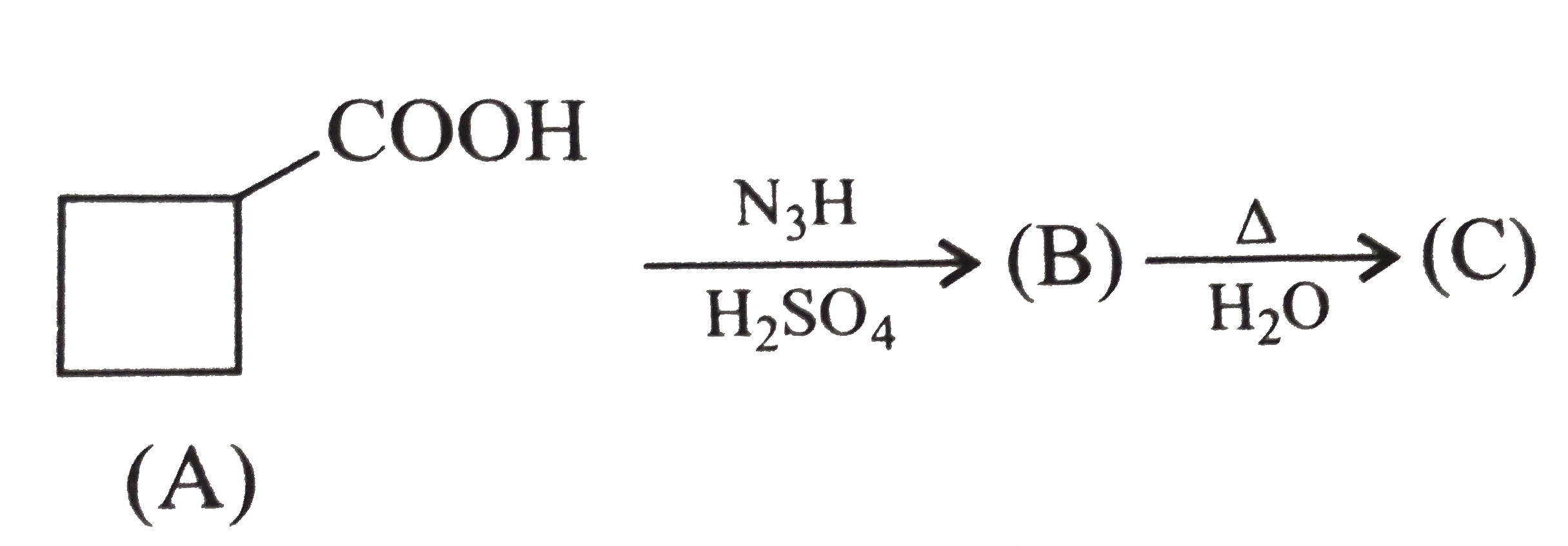A and B in the following reactions are :
RCOR'HCN−−−−−→KCNAB−−→R.R'(C)(OH)(CH2NH2)
A=R.R'(C)(CN)(OH),B=Li[AlH4]
A=R.R'(C)(COOH)(OH),B=NH3
A=R.R'(C)(CN)(OH),B=H3O+
A=R.R'CH2CN,B=NaOH
The correct Answer is:A
To solve the question regarding the reactions involving A and B, we need to analyze the given reactions step by step.
Step 1: Identify the Initial Compound
The initial compound is given as R−C(=O)−R′. This structure represents a ketone, specifically an unsymmetrical ketone since R and R' are different groups.
Hint: Remember that ketones have the general structure R−C(=O)−R′, where the carbonyl carbon is bonded to two alkyl groups.
Step 2: Reaction with KCN and HCN
The ketone undergoes a nucleophilic addition reaction with potassium cyanide (KCN) and hydrogen cyanide (HCN). In this reaction, the cyanide ion (CN⁻) acts as a nucleophile and attacks the electrophilic carbon of the carbonyl group.
Hint: Nucleophilic addition involves a nucleophile attacking an electrophilic carbon, leading to the formation of a tetrahedral intermediate.
Step 3: Formation of Compound A
After the nucleophilic attack, we form a tetrahedral intermediate. This intermediate can be represented as R−C(OH)(R′)−C (where C is the cyanide). Upon protonation, we get compound A, which is R−C(OH)(R′)−CN.
Hint: The addition of water or H⁺ to the tetrahedral intermediate leads to the formation of an alcohol (or hydroxyl compound).
Step 4: Reaction of Compound A
Next, compound A undergoes a further reaction. The cyanide group (CN) in compound A is converted into an amine group (–CH₂NH₂) through reduction. This reduction is typically achieved using lithium aluminum hydride (LiAlH₄), a strong reducing agent.
Hint: Reducing agents like LiAlH₄ can convert nitriles (CN) into primary amines (–CH₂NH₂).
Step 5: Identify Compound B
After the reduction of compound A, we obtain compound B, which is R−C(OH)(R′)−CH₂NH₂. This indicates that the cyanide group has been successfully reduced to an amine.
Hint: The product of the reduction will have the same carbon skeleton as the starting ketone but will now have an amine group instead of the cyanide group.
Conclusion
To summarize:
- Compound A is R−C(OH)(R′)−CN (the product of the nucleophilic addition).
- Compound B is R−C(OH)(R′)−CH₂NH₂ (the product of the reduction of A).
Final Answer:
- A = R−C(OH)(R′)−CN
- B = LiAlH₄ (lithium aluminum hydride)
The initial compound is given as R−C(=O)−R′. This structure represents a ketone, specifically an unsymmetrical ketone since R and R' are different groups.
The ketone undergoes a nucleophilic addition reaction with potassium cyanide (KCN) and hydrogen cyanide (HCN). In this reaction, the cyanide ion (CN⁻) acts as a nucleophile and attacks the electrophilic carbon of the carbonyl group.
After the nucleophilic attack, we form a tetrahedral intermediate. This intermediate can be represented as R−C(OH)(R′)−C (where C is the cyanide). Upon protonation, we get compound A, which is R−C(OH)(R′)−CN.
Next, compound A undergoes a further reaction. The cyanide group (CN) in compound A is converted into an amine group (–CH₂NH₂) through reduction. This reduction is typically achieved using lithium aluminum hydride (LiAlH₄), a strong reducing agent.
After the reduction of compound A, we obtain compound B, which is R−C(OH)(R′)−CH₂NH₂. This indicates that the cyanide group has been successfully reduced to an amine.
To summarize:
- Compound A is R−C(OH)(R′)−CN (the product of the nucleophilic addition).
- Compound B is R−C(OH)(R′)−CH₂NH₂ (the product of the reduction of A).
- A = R−C(OH)(R′)−CN
- B = LiAlH₄ (lithium aluminum hydride)
Similar Questions
Knowledge Check
A and B in the following reaction are
R - C - R' HCN/KCN−−−−−−→B−−→
 A
A B
B C
C DA=R'CH(CN)2,B=NaOH
DA=R'CH(CN)2,B=NaOHThe products X and Y in the following reaction are
R−CH2NO2(i)OH−−−−−−→(ii)R'BrXTiCl3−−→Y respectively,ARR'CHNO2,RR'COBRR'CO,RR'CHNO2CRR'CHNO2,RCH=NORDRCHNOR', R R'C=NOH_(2).In the following sequece of reactions, the end product is:
CH3CHOHCN−−→(A)H2O−−→(B)ACH3COOHBCH3CHOCOOHCCH3CH2NH2DCH3CONH2
Give the structures of A, B and C in the following reaction :
CH3BrKCN−−→ALiAlH4−−−→BHNO2−−−−−−→273KC.
View SolutionWrite the structures of compounds A, B and C in the following reactions :
(a) CH3−COOHNH3/Δ−−−−→ABr2/KOH−−−−−−→BCHCl3+alc.KOH−−−−−−−−−−−→C
(b) C6H5N+2BF−4NaNO2/Cu−−−−−−−−−→ΔAFe/HCl−−−−→BCH3COCl/Pyre−−−−−−−−−→C
View SolutionComplete the following reactions :
(a)
(b)
( c) Me−COOH(A)NH2OH−−−−→(B)ΘOH−−→(C)
(d)
( e) .
.
View SolutionA' in the following series of reaction is :
A[O]−−→BNH3OH−−−−→(CH3)2C=N−OH
View SolutionThe end product (B) in the following sequence of reactions is CH3ClKCN−−→AH2O/H+−−−−−→B
View Solution
